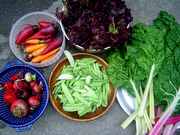

|
| Vegetable Varieties for Gardeners is a citizen science program
|
|
|
|
'Seminole' Pumpkins |
| |
| Sub-Category: |
Small
Pie (Culinary)
|
| |
|
| Sub-Category 2: |
| | Description: |
Heirloom pumpkin/squash cultivated by Seminoles in Florida for centuries. Vines bear orange-fleshed, bell-shaped, buff-colored, 7-inch fruit. Resistant to vine borers. Keeps well.
|
| Days To Maturity: |
95
|
| Seed Sources: |
|
| |
| Rating Summary |
| |
Overall: (3.7 Stars)
Taste: (3.3 Stars)
Yield: (3.7 Stars)
Ease/Reliability: (3.7 Stars) |
| |
| Reviews |
| |
Login to share your Review of Seminole.
Number of Reviews: 3
KEY: O=Overall Rating, T=Taste, Y=Yield, E=Ease
Reviewed on 12/28/2011 by
gardengrover
- An experienced gardener
|
 Overall Overall
 Taste Taste
 Yield Yield
 Ease Ease
|
Alachua, Florida, United States
Frost Free Season: More than 203 days
Soil Texture: Sand
Garden Size: Large - More than 1,600 square feet (40' x 40')
Sun Exposure: More than 8 hours per day
|
| Knock your socks off Flavor, great production, low maintenance, and as native as food gets. If you live in the South where it is hot and humid this is a must have in the garden.
Well adapted to the Southeast after at least hundreds of years of cultivation in the region. Seminole warriors largely survived off growing this squash up ringed trees in the swamps of Florida.(where they had retreated from the north to make their last stand against the pioneers) The Seminoles were the only tribe that never surrendered. It makes sense that this squash played a big role in sustaining them in an environment that was at the time very difficult to cultivate. The shelf life is incredible! - I have left a ripe pumpkin on a porch in partial sun for 9 months and it was still perfect to eat.
These taste almost identical to a Butternut Pumpkin. Strangely I tried quite a few of them in Southern California and they would not set fruit. In florida they are great to plant on the edge of a lawns, forest edges, or over weeds and brushpiles. This fruit does not set well on the ground - pick up the vines if you want to get good production. I start a patch after last frost to get summer and fall production and a patch in late summer for production clear into December. Use these as pioneer plants to overtake the weedy wilderness. Great for soups, pies, baked seeds, eating straight up - you should cultivate this plant it kicks ass and makes the best food in town! |
| | | 3 of 3 gardeners found this review helpful.
|
|
Reviewed on 05/05/2011 by
GardenerHI
- An experienced gardener
|
 Overall Overall
 Taste Taste
 Yield Yield
 Ease Ease
|
Honolulu, Hawaii, United States
Frost Free Season: More than 203 days
Soil Texture: Sand
Garden Size: Small - Less than 400 square feet (20' x 20')
Sun Exposure: More than 8 hours per day
|
| A very productive native American squash, best grown in Southern or Coastal gardens. Needs about 100 days to mature. Easy to grow, but not a naturally compact plant. Vine can get very large (long), unless you prune it to keep it small. However, pruned vines kept into about a 4 foot wide by 5 foot long by 4 foot tall area will still bear a good crop.
Very powdery mildew resistant. Also resistant to squash borers and soil wilts. Flavor is good, and appearance of fruit can vary. They may be orange, or green with white stripes. |
| | | 2 of 2 gardeners found this review helpful.
|
|
Reviewed on 02/28/2011 by
Joseph L
- An experienced gardener
|
 Overall Overall
Taste
 Yield Yield
 Ease Ease
|
Cache, Utah, United States
Frost Free Season: Fewer than 103 days
Soil Texture: Clay
Garden Size: Large - More than 1,600 square feet (40' x 40')
Sun Exposure: More than 8 hours per day
|
| Too long season for my garden. Didn't even come close to producing a fruit in 88 days in the 2010 growing season. |
| | | 1 of 1 gardener found this review helpful.
|
|
|
|
|
Vegetable Varieties for Gardeners is a citizen science program, © 2004-2024, All Rights Reserved
Cornell Garden Based Learning, Cornell University College of Agriculture & Life Sciences, Horticulture Section
|






 VVfG home
VVfG home
 Overall
Overall Overall
Overall
